
The All-America Football Conference (AAFC) was a major professional American football league that challenged the established National Football League (NFL) from 1946 to 1949. One of the NFL's most formidable challengers, the AAFC attracted many of the nation's best players, and introduced many lasting innovations to the game. However, the AAFC was ultimately unable to sustain itself in competition with the NFL. After it folded, three of its teams were admitted to the NFL: the San Francisco 49ers, the Cleveland Browns and the original Baltimore Colts.

The Dallas Texans played in the National Football League (NFL) for one season in 1952. They posted a record of 1–11.

The Boston Yanks were a National Football League team based in Boston, Massachusetts, that played from 1944 to 1948. The team played its home games at Fenway Park. Any games that conflicted with the Boston Red Sox baseball schedule in the American League were held at Braves Field of the cross-town National League team, the Boston Braves. Team owner Ted Collins, who managed singer and television show host Kate Smith (1907–1986) for thirty years, picked the name Yanks because he originally wanted to run a team that played at New York City's old Yankee Stadium. The Yanks managed only a 2–8 record during their first regular season.
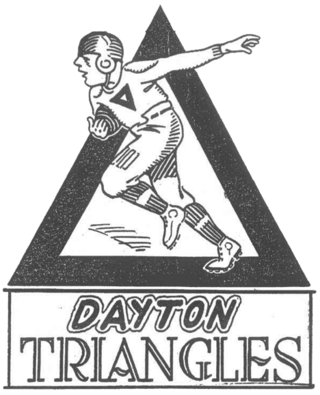
The Dayton Triangles were an original franchise of the American Professional Football Association in 1920. The Triangles were based in Dayton, Ohio, and took their nickname from their home field, Triangle Park, which was located at the confluence of the Great Miami and Stillwater Rivers in north Dayton. They were the longest-lasting traveling team in the NFL (1920–1929), and the last such "road team" until the Dallas Texans in 1952, who, coincidentally, descended from the Dayton franchise.
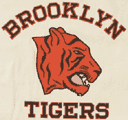
The Brooklyn Dodgers were an American football team that played in the National Football League from 1930 to 1943, and in 1944 as the Brooklyn Tigers. The team played its home games at Ebbets Field of the baseball National League's team, the Brooklyn Dodgers. In 1945, because of financial difficulties and the increasing scarcity of major league–level players because of the war-time defense requirements at the height of World War II, the team was merged with the Boston Yanks and were known as the Yanks for that season.

The Baltimore Colts were a professional American football team based in Baltimore, Maryland. The first team to bear the name, it was a member of the All-America Football Conference (AAFC) from 1947 to 1949 and then joined the National Football League (NFL) for one season before folding. The Colts were one of the least successful teams in the AAFC and NFL both on and off the field, winning only 11 of their 54 games in their history. In 1953, Baltimore was granted an expansion team that revived the Colts name. That franchise moved in 1984 and became the Indianapolis Colts.
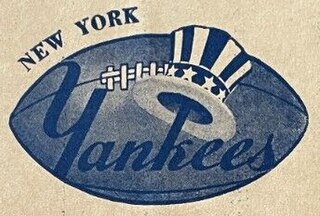
The New York Yankees were a professional American football team that played in the All-America Football Conference (AAFC) from 1946 to 1949. The team played in Yankee Stadium in the Bronx. They were owned by Dan Topping, who transferred the team from the NFL Brooklyn Dodgers, retaining many of the same players. The team's coach was Ray Flaherty, who had coached the Washington Redskins in the early 1940s. Former NFL player Jim Barber served as an assistant coach under Flaherty.
The 1949 NFL season was the 30th regular season of the National Football League. Prior to the season, Boston Yanks owner Ted Collins asked the league to fold his team due to financial woes, and give him a new one in New York City. This new team would be called the New York Bulldogs. The franchise, which has never missed a season in some form, carried on the legacy of the final Ohio League member Dayton Triangles, and its players and assets were moved to New York but not specifically folded. As a result of the move, professional football would not return to Boston until the Patriots began play in 1960.
The 1950 NFL season was the 31st regular season of the National Football League. The merger with the All-America Football Conference (AAFC) expanded the league to 13 teams. Meanwhile, television brought a new era to the game. The Los Angeles Rams became the first NFL team to have all of its games – both home and away – televised. The Washington Redskins became the second team to put their games on TV. Other teams arranged to have selected games televised.
The Buffalo Bills were an American football team, based in Buffalo, New York, that played in the All-America Football Conference from 1946 to 1949. During its first season in 1946, the team was known as the Buffalo Bisons. Unlike the Cleveland Browns, San Francisco 49ers, and Baltimore Colts, the franchise was not one of the three AAFC teams that merged with the National Football League prior to the 1950 season. It was named after Buffalo Bill.
Throughout the years, a number of teams in the National Football League (NFL) have either moved or merged.

Norman Parker "Red" Strader was an American football player and coach who served in both capacities at the collegiate and professional levels. In the college ranks, he spent two years as head coach at Saint Mary's College of California, and later held the same position with the New York Yankees of the All-America Football Conference (AAFC), and the New York Yanks and San Francisco 49ers of the National Football League (NFL).
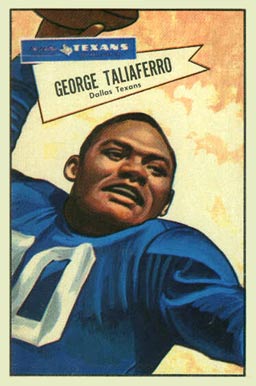
George Taliaferro was a professional American football player who was the first African American drafted by a National Football League (NFL) team. Beginning his football career at Indiana University for the Hoosiers team, he played in the NFL for the New York Yanks from 1950 to 1951, the Dallas Texans in 1952, the Baltimore Colts from 1953 to 1954, and Philadelphia Eagles in 1955.
The 1949 Cleveland Browns season was the team's fourth and final season in the All-America Football Conference (AAFC). The Browns finished the regular season with a 9–1–2 win–loss–tie record and beat the San Francisco 49ers to win their fourth straight league championship. In the season's sixth game on October 9, the 49ers stopped the Browns' professional football record unbeaten streak at 29 games. It began two years earlier on October 19, 1947, and included two league championship games and two ties.
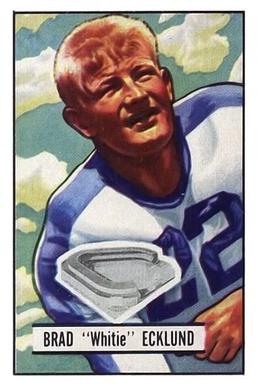
Bradford Sterling Ecklund was a center in the All-America Football Conference (AAFC) and in the National Football League (NFL). He was chosen twice to play in the Pro Bowl. He was born in Los Angeles and died in Mount Holly Township, New Jersey.

Martin Owen Ruby was an offensive tackle and defensive tackle for the New York Yankees and the Brooklyn Dodgers in the All-America Football Conference (AAFC), New York Yanks of the National Football League (NFL), and the Saskatchewan Roughriders of the Western Interprovincial Football Union. He lived in Waco, Texas, while he was a professional player.
The American Football League (AFL) was a professional American football league that operated in 1936 and 1937. The AFL operated in direct competition with the more established National Football League (NFL) throughout its existence. While the American media generally ignored its operation, this second AFL was the first "home" of the Cleveland Rams, which joined the National Football League after one year in the AFL.
The 1951 New York Yanks season was their second as the Yanks, and their final season before the franchise was sold and moved to Dallas. The team failed to improve on their previous season's output of 7–5, winning only one game. They played eight of their twelve games on the road, including seven of the first eight. The sole victory came at Green Bay in early December. The final game against the neighboring Giants drew less than 6,700, played on an icy field with game time temperature of 17 °F (−8 °C).
On December 9, 1949, the National Football League absorbed three teams from the All-America Football Conference.
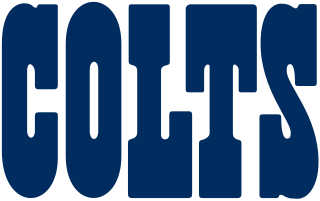
The Baltimore Colts were a professional American football team that played in Baltimore from 1953 to 1983, when owner Robert Irsay moved the franchise to Indianapolis. The team was named for Baltimore's history of horse breeding and racing. It was the second incarnation of the Baltimore Colts, the first having played for three years in the All-America Football Conference and one in the National Football League (NFL). This Baltimore Colts played their home games at Memorial Stadium.












